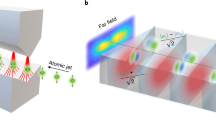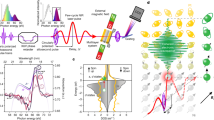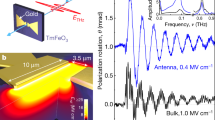Abstract
Combining highly coherent spin control with efficient light-matter coupling offers great opportunities for quantum communication and computing. Optically active semiconductor quantum dots have unparalleled photonic properties but also modest spin coherence limited by their resident nuclei. The nuclear inhomogeneity has thus far bound all dynamical decoupling measurements to a few microseconds. Here, we eliminate this inhomogeneity using lattice-matched GaAs–AlGaAs quantum dot devices and demonstrate dynamical decoupling of the electron spin qubit beyond 0.113(3) ms. Leveraging the 99.30(5)% visibility of our optical π-pulse gates, we use up to Nπ = 81 decoupling pulses and find a coherence time scaling of \({N}_{\uppi }^{0.75(2)}\). This scaling manifests an ideal refocusing of strong interactions between the electron and the nuclear spin ensemble, free of extrinsic noise, which holds the promise of lifetime-limited spin coherence. Our findings demonstrate that the most punishing material science challenge for such quantum dot devices has a remedy and constitute the basis for highly coherent spin–photon interfaces.
This is a preview of subscription content, access via your institution
Access options
Access Nature and 54 other Nature Portfolio journals
Get Nature+, our best-value online-access subscription
$29.99 / 30 days
cancel any time
Subscribe to this journal
Receive 12 print issues and online access
$259.00 per year
only $21.58 per issue
Buy this article
- Purchase on Springer Link
- Instant access to full article PDF
Prices may be subject to local taxes which are calculated during checkout




Similar content being viewed by others
Data availability
The data that support the findings of this study are available from the corresponding authors upon request.
Code availability
The code that models the decoherence of the dynamically decoupled electron spin is available at https://github.com/CoherentQD/CPMG_simulation.
References
Nickerson, N. H., Fitzsimons, J. F. & Benjamin, S. C. Freely scalable quantum technologies using cells of 5-to-50 qubits with very lossy and noisy photonic links. Phys. Rev. X 4, 041041 (2014).
Monroe, C. et al. Large-scale modular quantum-computer architecture with atomic memory and photonic interconnects. Phys. Rev. A 89, 022317 (2014).
Cohen, L. Z., Kim, I. H., Bartlett, S. D. & Brown, B. J. Low-overhead fault-tolerant quantum computing using long-range connectivity. Sci. Adv. 8, eabn1717 (2022).
Gimeno-Segovia, M., Shadbolt, P., Browne, D. E. & Rudolph, T. From three-photon Greenberger-Horne-Zeilinger states to ballistic universal quantum computation. Phys. Rev. Lett. 115, 020502 (2015).
Stephenson, L. J. et al. High-rate, high-fidelity entanglement of qubits across an elementary quantum network. Phys. Rev. Lett. 124, 110501 (2020).
Postler, L. et al. Demonstration of fault-tolerant universal quantum gate operations. Nature 605, 675–680 (2022).
Abobeih, M. H. et al. Fault-tolerant operation of a logical qubit in a diamond quantum processor. Nature 606, 884–889 (2022).
Bergeron, L. et al. Silicon-integrated telecommunications photon-spin interface. PRX Quantum 1, 020301 (2020).
Christle, D. J. et al. Isolated spin qubits in SiC with a high-fidelity infrared spin-to-photon interface. Phys. Rev. X 7, 021046 (2017).
Ruskuc, A., Wu, C.-J., Rochman, J., Choi, J. & Faraon, A. Nuclear spin-wave quantum register for a solid-state qubit. Nature 602, 408–413 (2022).
Raha, M. et al. Optical quantum nondemolition measurement of a single rare earth ion qubit. Nat. Commun. 11, 1605 (2020).
Berezovsky, J., Mikkelsen, M. H., Stoltz, N. G., Coldren, L. A. & Awschalom, D. D. Picosecond coherent optical manipulation of a single electron spin in a quantum dot. Science 320, 349–352 (2008).
De Greve, K. et al. Ultrafast coherent control and suppressed nuclear feedback of a single quantum dot hole qubit. Nat. Phys. 7, 872–878 (2011).
Godden, T. M. et al. Coherent optical control of the spin of a single hole in an InAs/GaAs quantum dot. Phys. Rev. Lett. 108, 017402 (2012).
Pfaff, W. et al. Unconditional quantum teleportation between distant solid-state quantum bits. Science 345, 532–535 (2014).
Pompili, M. et al. Realization of a multinode quantum network of remote solid-state qubits. Science 372, 259–264 (2021).
Schwartz, I. et al. Deterministic generation of a cluster state of entangled photons. Science 354, 434–437 (2016).
Istrati, D. et al. Sequential generation of linear cluster states from a single photon emitter. Nat. Commun. 11, 5501 (2020).
Wang, H. et al. Towards optimal single-photon sources from polarized microcavities. Nat. Photon. 13, 770–775 (2019).
Liu, J. et al. A solid-state source of strongly entangled photon pairs with high brightness and indistinguishability. Nat. Nanotechnol. 14, 586–593 (2019).
Tomm, N. et al. A bright and fast source of coherent single photons. Nat. Nanotechnol. 16, 399–403 (2021).
Appel, M. H. et al. Coherent spin-photon interface with waveguide induced cycling transitions. Phys. Rev. Lett. 126, 013602 (2021).
Thomas, S. E. et al. Bright polarized single-photon source based on a linear dipole. Phys. Rev. Lett. 126, 233601 (2021).
Varnava, M., Browne, D. E. & Rudolph, T. How good must single photon sources and detectors be for efficient linear optical quantum computation? Phys. Rev. Lett. 100, 060502 (2008).
Pant, M., Towsley, D., Englund, D. & Guha, S. Percolation thresholds for photonic quantum computing. Nat. Commun. 10, 1070 (2019).
Press, D., Ladd, T. D., Zhang, B. & Yamamoto, Y. Complete quantum control of a single quantum dot spin using ultrafast optical pulses. Nature 456, 218–221 (2008).
De Greve, K. et al. Quantum-dot spin–photon entanglement via frequency downconversion to telecom wavelength. Nature 491, 421–425 (2012).
Appel, M. H. et al. Entangling a hole spin with a time-bin photon: a waveguide approach for quantum dot sources of multiphoton entanglement. Phys. Rev. Lett. 128, 233602 (2022).
Delteil, A. et al. Generation of heralded entanglement between distant hole spins. Nat. Phys. 12, 218–223 (2016).
Stockill, R. et al. Phase-tuned entangled state generation between distant spin qubits. Phys. Rev. Lett. 119, 010503 (2017).
Gangloff, D. A. et al. Quantum interface of an electron and a nuclear ensemble. Science 364, 62–66 (2019).
Taylor, J. M., Marcus, C. M. & Lukin, M. D. Long-lived memory for mesoscopic quantum bits. Phys. Rev. Lett. 90, 206803 (2003).
Denning, E. V., Gangloff, D. A., Atatüre, M., Mørk, J. & Le Gall, C. Collective quantum memory activated by a driven central spin. Phys. Rev. Lett. 123, 140502 (2019).
Stockill, R. et al. Quantum dot spin coherence governed by a strained nuclear environment. Nat. Commun. 7, 12745 (2016).
Gong, Q., Offermans, P., Nötzel, R., Koenraad, P. M. & Wolter, J. H. Capping process of InAs/GaAs quantum dots studied by cross-sectional scanning tunneling microscopy. Appl. Phys. Lett. 85, 5697 (2004).
Bechtold, A. et al. Three-stage decoherence dynamics of an electron spin qubit in an optically active quantum dot. Nat. Phys. 11, 1005–1008 (2015).
Covre da Silva, S. F. et al. GaAs quantum dots grown by droplet etching epitaxy as quantum light sources. Appl. Phys. Lett. 119, 120502 (2021).
Schöll, E. et al. Resonance fluorescence of GaAs quantum dots with near-unity photon indistinguishability. Nano Lett. 19, 2404–2410 (2019).
Zhai, L. et al. Low-noise GaAs quantum dots for quantum photonics. Nat. Commun. 11, 4745 (2020).
Chekhovich, E. A., Covre da Silva, S. F. & Rastelli, A. Nuclear spin quantum register in an optically active semiconductor quantum dot. Nat. Nanotechnol. 15, 999–1004 (2020).
Schimpf, C., Manna, S., Covre da Silva, S. F., Aigner, M. & Rastelli, A. Entanglement-based quantum key distribution with a blinking-free quantum dot operated at a temperature up to 20 K. Adv. Photon. 3, 065001 (2021).
Kuhlmann, A. V. et al. Charge noise and spin noise in a semiconductor quantum device. Nat. Phys. 9, 570–575 (2013).
Gillard, G. et al. Fundamental limits of electron and nuclear spin qubit lifetimes in an isolated self-assembled quantum dot. npj Quantum Inf. 7, 43 (2021).
Bodey, J. H. et al. Optical spin locking of a solid-state qubit. npj Quantum Inf. 5, 95 (2019).
Cywiński, Ł., Witzel, W. M. & Das Sarma, S. Pure quantum dephasing of a solid-state electron spin qubit in a large nuclear spin bath coupled by long-range hyperfine-mediated interactions. Phys. Rev. B 79, 245314 (2009).
Botzem, T. et al. Quadrupolar and anisotropy effects on dephasing in two-electron spin qubits in GaAs. Nat. Commun. 7, 11170 (2016).
Bluhm, H. et al. Dephasing time of GaAs electron-spin qubits coupled to a nuclear bath exceeding 200 μs. Nat. Phys. 7, 109–113 (2011).
Malinowski, F. K. et al. Notch filtering the nuclear environment of a spin qubit. Nat. Nanotechnol. 12, 16–20 (2016).
Malinowski, F. K. et al. Spectrum of the nuclear environment for GaAs spin qubits. Phys. Rev. Lett. 118, 177702 (2017).
de Lange, G., Wang, Z. H., Ristè, D., Dobrovitski, V. V. & Hanson, R. Universal dynamical decoupling of a single solid-state spin from a spin bath. Science 330, 60–63 (2010).
Huthmacher, L. et al. Coherence of a dynamically decoupled quantum-dot hole spin. Phys. Rev. B 97, 241413 (2018).
Ragunathan, G. Nuclear Spin Phenomena in III-V and II-VI Semiconductor Quantum Dots. PhD thesis, University of Sheffield (2019).
Ulhaq, A. et al. Vanishing electron g factor and long-lived nuclear spin polarization in weakly strained nanohole-filled GaAs/AlGaAs quantum dots. Phys. Rev. B 93, 165306 (2016).
Chekhovich, E. A., Hopkinson, M., Skolnick, M. S. & Tartakovskii, A. I. Suppression of nuclear spin bath fluctuations in self-assembled quantum dots induced by inhomogeneous strain. Nat. Commun. 6, 6348 (2015).
Knijn, P. J. et al. A solid-state NMR and DFT study of compositional modulations in AlxGa1−xAs. Phys. Chem. Chem. Phys. 12, 11517–11535 (2010).
Chekhovich, E. A. et al. Measurement of the spin temperature of optically cooled nuclei and GaAs hyperfine constants in GaAs/AlGaAs quantum dots. Nat. Mater. 16, 982–986 (2017).
van Bree, J. et al. Anisotropy of electron and hole g tensors of quantum dots: an intuitive picture based on spin-correlated orbital currents. Phys. Rev. B 93, 035311 (2016).
Wolters, J. et al. Simple atomic quantum memory suitable for semiconductor quantum dot single photons. Phys. Rev. Lett. 119, 060502 (2017).
Heyn, C. et al. Highly uniform and strain-free GaAs quantum dots fabricated by filling of self-assembled nanoholes. Appl. Phys. Lett. 94, 183113 (2009).
Atkinson, P., Zallo, E. & Schmidt, O. G. Independent wavelength and density control of uniform GaAs/AlGaAs quantum dots grown by infilling self-assembled nanoholes. J. Appl. Phys. 112, 054303 (2012).
Huo, Y. H., Rastelli, A. & Schmidt, O. G. Ultra-small excitonic fine structure splitting in highly symmetric quantum dots on GaAs (001) substrate. Appl. Phys. Lett. 102, 152105 (2013).
Houel, J. et al. Probing single-charge fluctuations at a GaAs/AlAs interface using laser spectroscopy on a nearby InGaAs quantum dot. Phys. Rev. Lett. 108, 107401 (2012).
Virtanen, P. et al. SciPy 1.0: fundamental algorithms for scientific computing in Python. Nat. Methods 17, 261–272 (2020).
Chekhovich, E. A. et al. Cross calibration of deformation potentials and gradient-elastic tensors of GaAs using photoluminescence and nuclear magnetic resonance spectroscopy in GaAs/AlGaAs quantum dot structures. Phys. Rev. B 97, 235311 (2018).
Neder, I. et al. Semiclassical model for the dephasing of a two-electron spin qubit coupled to a coherently evolving nuclear spin bath. Phys. Rev. B 84, 035441 (2011).
Acknowledgements
We acknowledge support from the Royal Society (EA/181068; C.L.G.), the US Office of Naval Research Global (N62909-19-1-2115; M.A.), the EU Horizon 2020 FET Open project QLUSTER (862035; C.L.G. and M.A.), the EU Horizon 2020 research and innovation programme under Marie Sklodowska-Curie grant QUDOT-TECH (861097; M.A.), Qurope (899814; A.R.), ASCENT+ (871130; A. R.), Engineering and Physical Sciences Research Council grant EP/V048333/1 (E.A.C.) and the Austrian Science Fund (FWF; FG 5, P 30459, I 4380, I 4320 and I 3762; A.R.), the LIT Secure and Correct Systems Lab platform is funded by the state of Upper Austria. L.Z., J.H.B. and D.M.J. acknowledge support from the EPSRC DTP. D.A.G. acknowledges a St. John’s College Fellowship and a Royal Society University Research Fellowship; C.LG., a Dorothy Hodgkin Royal Society Fellowship; and E.A.C., a Royal Society University Research Fellowship. We also thank Ł. Cywiński, M. E. Flatté, C. E. Pryor, H. Bluhm, P. Atkinson, A. J. Garcia, G. Undeutsch and P. Klenovský for fruitful discussions.
Author information
Authors and Affiliations
Contributions
L.Z., D.A.G., M.A. and C.L.G. conceived the spin control experiments; E.A.C. conceived the NMR experiments; and E.A.C. and A.R. conceived the QD device. L.Z., J.H.B., N.S., M.H.A., G.D., G.P. and C.L.G. carried out the spin control and resonance fluorescence experiments; L.Z. and C.L.G. performed the corresponding data analysis, theory and simulations; G.G. and E.A.C. carried out the NMR experiments; S.M. and S.C.d.S. performed the molecular beam epitaxy growth; and C.S. characterized the samples. S.M., J.J. and N.S. processed the QD devices. All authors contributed to the discussion of the analysis and the results. All authors participated in the preparation of the manuscript.
Corresponding authors
Ethics declarations
Competing interests
The authors declare no competing interests.
Peer review
Peer review information
Nature Nanotechnology thanks the anonymous reviewers for their contribution to the peer review of this work.
Additional information
Publisher’s note Springer Nature remains neutral with regard to jurisdictional claims in published maps and institutional affiliations.
Extended data
Extended Data Fig. 1 QD device.
Schematics of the QD device outlining the composition of the n–i–p heterostructure (Linz Ref. SA0553), the electrical contacts (Methods) and the solid immersion lens (SIL).
Extended Data Fig. 2 Experimental set-up.
AOM = acousto-optic modulator; EOM = electro-optic modulator; APD = avalanche photodiode; AWG = arbitrary waveform generator. Colors of the laser beams correspond to the driven processes (readout, depolarization and spin control) outlined in the energy level diagram on the right.
Extended Data Fig. 3 π-pulse visibility.
a, Visibility measurement on a 40s timescale with Nπ = 162. The left panel displays the readout signal for \(\left\vert \uparrow \right\rangle\) -state initialization. The integrated counts under the yellow dark-shaded area are background-subtracted with the counts in the yellow light-shaded area, yielding cts↑ = 1753. The right panel displays the readout signal following the same pulse sequence with an additional π-pulse (\(\left\vert \downarrow \right\rangle\)-state initialization) yielding cts↓ = 917. This corresponds to a π-pulse visibility of \({{{\mathcal{F}}}}=99.30(5) \%\) (Methods). b, Visibility on long timescales. Data points display the fitted maximal visibility, \({v}_{\max }\), in long CPMG measurements as a function of the number of π-pulses in the sequence, Nπ. The black curve illustrates that a π-pulse visibility \(\bar{{{{\mathcal{F}}}}}=97.81(5) \%\) is typically achieved over longer integration times (Methods). The error bars represent the standard deviation errors on fit parameter \({v}_{\max }\).
Extended Data Fig. 4 NMR datasets.
a, Inverse NMR spectrum of nuclear transition frequencies resolved in an extrinsically strained device (\({\nu }_{Q}^{{{{\rm{ext}}}}}=250\) kHz), displaying a sharp central transition (CT) together with broader satellite transitions (ST). b, Inverse NMR lineshape of the blue-detuned satellite transition together with a skew-normal fit (the red solid curve), given by a function S(A)(ν) from Eq. (8) in Methods, with fitted parameters A = 158(1) μeV × kHz, μ(A) = 252.21(4) kHz, σ(A) = 9.74(8) kHz, ζ(A) = 3.22(8) and C = 0.72(3) μeV, corresponding to a FWHM = 22.9(2) kHz. c, Integral NMR spectrum of the blue-detuned satellite transition. The solid red curve displays the normalized cumulative distribution obtained from the fit to the data in Extended Data Fig. 4b (cf. Eq. (10) in Methods); the mismatch indicates the presence of a broader pedestal (see Fig. 4a), which we fit with a Gaussian distribution centred at μ(B) = 246(2) kHz with FWHM = 172(9) kHz and relative weight β = 0.244(7). The resulting sum fit, given by function CDF(ν) from Eq. (11) in Methods (normalized to 13.09 μeV), is displayed as the turquoise solid curve.
Extended Data Fig. 5 Global fit to the CPMG dataset.
The electronic coherence function from the Eq. (15), that is W⊥(t), was calculated with our model and globally fitted to the CPMG data sub-sets (the black points) with: a, Nπ = 1, b, Nπ = 2, c, Nπ = 3, d, Nπ = 4, e, Nπ = 5, f, Nπ = 8, g, Nπ = 9, h, Nπ = 27 and i, Nπ = 81, all taken at B = 6.5 T. The set of the solid red curves displays the best global fit.
Extended Data Fig. 6 Assessing the goodness of the global fit to the CPMG dataset.
Weighted residual sum of squares per data point, averaged over all the CPMG data subsets of varied Nπ, as a function of two global fit parameters: β and scaling factor κ. Best global fit is found for β = 0.35 and κ = 1.45.
Supplementary information
Supplementary Information
Supplementary Figs. 1–3, Tables 1 and 2 and Discussion.
Rights and permissions
Springer Nature or its licensor (e.g. a society or other partner) holds exclusive rights to this article under a publishing agreement with the author(s) or other rightsholder(s); author self-archiving of the accepted manuscript version of this article is solely governed by the terms of such publishing agreement and applicable law.
About this article
Cite this article
Zaporski, L., Shofer, N., Bodey, J.H. et al. Ideal refocusing of an optically active spin qubit under strong hyperfine interactions. Nat. Nanotechnol. 18, 257–263 (2023). https://doi.org/10.1038/s41565-022-01282-2
Received:
Accepted:
Published:
Issue Date:
DOI: https://doi.org/10.1038/s41565-022-01282-2
This article is cited by
-
Giant optical polarisation rotations induced by a single quantum dot spin
Nature Communications (2024)
-
Light–matter interactions in quantum nanophotonic devices
Nature Reviews Physics (2024)
-
Approaching a fully-polarized state of nuclear spins in a solid
Nature Communications (2024)
-
A diamond nanophotonic interface with an optically accessible deterministic electronuclear spin register
Nature Photonics (2024)
-
Novel multiple access protocols against Q-learning-based tunnel monitoring using flying ad hoc networks
Wireless Networks (2024)



